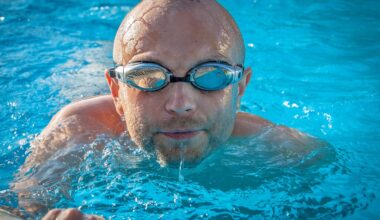How Swim Trackers Are Shaping the Future of Aquatic Fitness
In the realm of fitness technology, swim trackers have emerged as pivotal tools for enhancing the aquatic experience. These innovative devices go beyond basic timekeeping, offering comprehensive data analysis and feedback to swimmers. With functionalities ranging from lap counting to heart rate monitoring, they cater to competitive athletes and recreational swimmers alike. Many swim trackers employ waterproof designs, ensuring durability and reliability, even in the most challenging water environments. This waterproof capability is crucial since swim strokes and movements can affect overall performance. Furthermore, advancements in Bluetooth and other wireless technologies enable seamless syncing with smartphones. Swimmers can review their progress and analytics in real-time, transforming swim practices into data-driven training sessions. An additional benefit of swim trackers is their potential for injury prevention. By keeping track of stroke efficiency and body mechanics, users can adjust their techniques to avoid strain or injury. The incorporation of gamification elements also adds motivation, encouraging individuals to set and achieve personal goals. As a result, swim trackers have revolutionized how swimmers engage with their fitness routines, contributing immensely to the growth of aquatic fitness culture.
Features of Modern Swim Trackers
Modern swim trackers come equipped with a plethora of features designed to enhance swimming sessions. For starters, these devices often include detailed performance metrics, such as stroke count, distance swum, and lap times. Advanced models even provide insights into stroke efficiency and time per stroke, which can substantially optimize training. Additionally, many swim trackers now offer heart rate monitoring, allowing swimmers to maintain optimal levels during their workouts. This feature can ensure that users train within their target heart rate zones to improve aerobic capacity. Another impressive aspect is GPS integration for open water swimmers, tracking routes taken during outdoor swims. This functionality enhances the overall utility of a swim tracker, catering to those who prefer swimming in lakes and oceans. Furthermore, waterproof designs guarantee functionality and durability under various conditions. Among wearable technologies, swim trackers are specifically designed to withstand water pressure and resist damage caused by chlorine or saltwater. Users can also expect long battery life, ensuring continued use for lengthy swim sessions. These advanced features enable swimmers to track improvements seamlessly, fostering a deeper understanding of their aquatic capabilities.
Connectivity also plays a vital role in the effectiveness of swim trackers, particularly regarding data analysis and sharing. Most swim trackers allow users to sync their performance data with companion apps on smartphones or tablets. These apps typically offer customizable dashboards, presenting metrics in user-friendly formats that facilitate monitoring progress over time. Advanced analytics can include breakdowns of training volume and intensity, providing a comprehensive view of a swimmer’s regimen. Many apps offer social sharing features, enabling users to connect with friends and training partners, fostering a sense of community. This connectivity extends to fitness platforms and health monitoring systems. Swimmers can link their swim data with apps like Strava or MyFitnessPal for integrated fitness tracking. This ability encourages comprehensive health management and lifestyle tracking, transforming swim sessions into an integrated part of overall fitness routines. Additionally, synchronized updates assist coaches and trainers in following athlete performance, aiding in personalized coaching strategies. Overall, the connectivity features of swim trackers result in a more informed and motivated swimming experience, promoting continual improvement and accountability among users.
The Impact on Training Regimens
Swim trackers significantly impact training regimens, allowing swimmers to set realistic goals based on their performance statistics. Armed with precise data, swimmers can strategize their training sessions to target specific areas for improvement. For instance, if a swimmer identifies slow lap times, they can implement specific drills to enhance their speed. In competitive swimming, analyzing stroke patterns can lead to better techniques, allowing for an edge during competitions. Swim trackers also encourage a sense of discipline, as swimmers are able to monitor their training frequency and intensity accurately. With consistent tracking, athletes can adhere to prepared training schedules more effectively, translating to improved performance in the pool. Moreover, the adaptability of swim trackers supports varying training phases, such as endurance, speed, or technique strength. These devices provide the flexibility needed for tailored workouts, enabling personalized training plans that reflect a swimmer’s evolving capabilities. Swimmers often report increased motivation due to visible progress over time, fostering a more enjoyable training experience. Consequently, swim trackers represent a vital aspect of modern aquatic training methods, positioning swimmers for success at all levels, from novice to elite.
In addition to improving individual performance, swim trackers positively influence group training sessions and team dynamics. Coaches and trainers can utilize aggregated data from wearable devices to understand the strengths and weaknesses of their swimmers better. By analyzing overall team metrics, training plans can become more collective, addressing areas where the team may struggle as a whole. This data-informed strategy promotes open communication and collaboration within teams, enhancing the training experience. Athletes can compete against each other in a friendly manner, encouraging accountability within workouts while fostering comradery. Gamified elements, such as leaderboards based on lap times or distance swum, can stimulate healthy competition. Many swimmers enjoy tracking their progress against teammates, propelling motivation and driving each individual to reach new personal records. Furthermore, the participation of coaches in reviewing detailed analytics ensures they can provide targeted advice to each athlete. Such collaboration between swimmers and coaches enhances the overall effectiveness of training sessions, ultimately aiming for collective improvement. Hence, swim trackers not only enhance individual performance but also foster a strong sense of unity and teamwork essential for aquatic sports.
Health and Wellness Benefits
Beyond performance tracking, swim trackers offer significant health and wellness benefits that contribute to overall fitness. Increased engagement in swimming often leads to enhanced cardiovascular health, improved muscle strength, and increased flexibility. Regular use of swim trackers encourages swimmers to maintain a consistent routine. In this regard, they act as a motivational tool, allowing users to monitor workout completion and achievement of fitness goals. This is particularly helpful in maintaining accountability for those participating in health-focused programs. Studies have shown that incorporating swim workouts can lead to better joint health due to the low-impact nature of the activity. Swimming provides an excellent workout without excessive strain on the body, making it suitable for individuals of all ages. Additionally, swim trackers can help manage stress levels, encouraging mindfulness and relaxation while swimming. Many users report the meditative qualities associated with being in the water, leading to reduced anxiety. Tracking progress can improve self-esteem and mental well-being, contributing to an overall healthier lifestyle. As swim trackers continue to evolve, the health and wellness transformation they bring to individuals is becoming increasingly prominent in fitness communities.
Looking to the future, the evolution of swim trackers will continue to benefit aquatic fitness. As technology improves, we can expect further innovations, advanced analytics, and improved user interfaces. The integration of artificial intelligence could lead to personalized training suggestions, adapting in real-time based on user performance and progress. This could transform swim coaching, offering tailored insights and recommendations directly in the pool. Additionally, the enhancements in battery life will extend usage, allowing for longer swimming sessions without interruptions. Wearable technology such as swim trackers will likely become even more compact and intuitive, marrying functionality and comfort seamlessly. As awareness of aquatic fitness increases, more swimmers will adopt these devices, further supporting their mainstream acceptance. This trend will facilitate collaboration between manufacturers and professional coaches to create optimal training systems. Upcoming advancements in connectivity features may allow for real-time data exchange during swim meets, offering instant feedback on performance. As the landscape of aquatic fitness continues to evolve, swim trackers will remain at the forefront, influencing not just individual performance but also enhancing community engagement through swimming.
In summary, swim trackers are revolutionizing the aquatic fitness landscape, empowering swimmers to reach their maximum potential. Through advanced technologies, users gain detailed insights into their performances, which leads to improved training outcomes. The features of modern swim trackers—which include heart rate monitoring, GPS tracking, and connectivity—enhance both training and overall health benefits. Furthermore, these devices foster a sense of community, motivating swimmers through gamified experiences, accountability, and friendly competition. Their impact transcends individual performance, forging a stronger connected culture among athletes and coaches alike. As fitness technology continues to advance, we expect swim trackers will become indispensable in the journey towards aquatic fitness. The sustained engagement provided through these devices encourages consistency, accountability, and personal growth for swimmers of all skill levels. With a growing emphasis on mental well-being and overall health, the integration of swim trackers into fitness routines will bolster both physical and psychological benefits. Looking forward, the possibilities for both technology and fitness will be limitless, with swim trackers leading the charge in a future where aquatic fitness flourishes.


